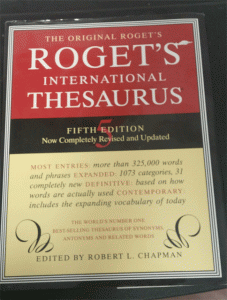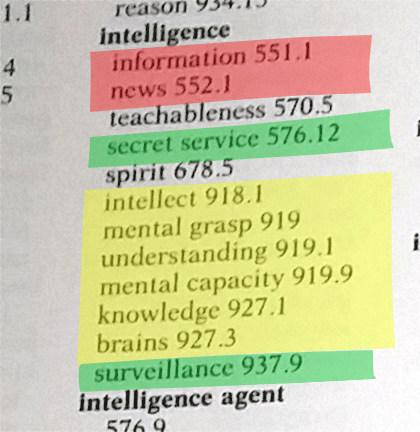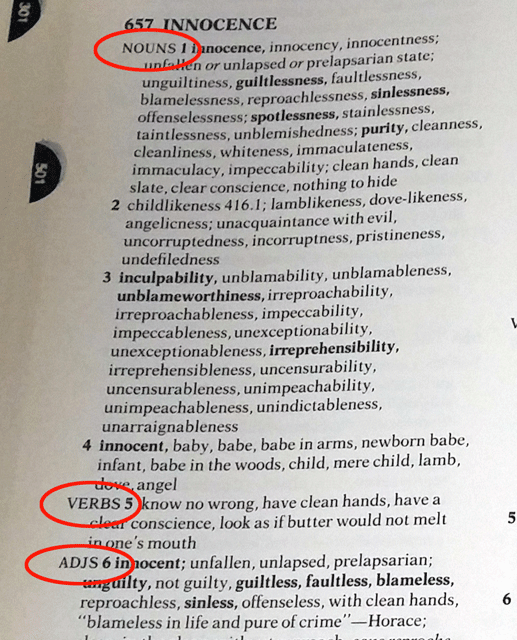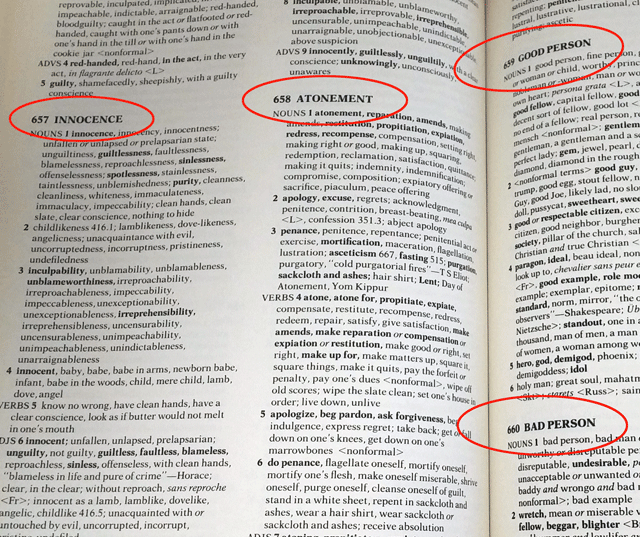
A few weeks ago on Facebook, someone commented in passing that they really needed to find a good thesaurus. The commenter was a friend of a friend, and so I don’t recall who it was. The pertinent fact was that she was a writer and was dissatisfied with the thesaurus she’d been using.
I read her comment and thought “I’ll bet that what she’s been using up to now has been a newer styled ‘dictionary’ type thesaurus, where it’s just a word list of synonyms.” But I also understood the challenge that she, as a writer, felt in the face of opening up that imposing hoard of words, Roget’s ORIGINAL Thesaurus.
The Dictionary Style
I seem to recall being taught somewhere around 8th or 9th grade about how to navigate the Roget’s original presentation. But at the time, it seemed awkward and confusing to me. I didn’t need the sophistication of it (although I didn’t realize then that’s what it was). I just needed a list of synonyms. I suspect a great number of people felt the same way. Roget’s original version got set aside, perhaps as being “old fashioned,” and hence useless.
Indeed, when I searched online in preparing this blog post for “how to use a thesaurus” what I found was the following:
1: Choose a word as a starting point.
2: Like a dictionary, find the word in the alphabetic arrangement.
3: Once you find the word, look at the words that are listed alongside the main word.
4: Choose another word that will work to replace your starting word.
Now the thing about this is that it only really satisfies if you want to keep your original sentence structure, even if that sentence structure doesn’t quite get you to the exact point you want. You can substitute “mansion, bungalow, chalet, residence, or lodging” for “house” in sales copy, depending on the size of the building (for a mansion is going to be larger than a bungalow). But otherwise, you don’t need to change the structure of your sentence.
But if you are a writer — or even more intensely, if you are a poet — simply replacing one word with a synonym isn’t going to satisfy you. And I really suspect that the complaint I mentioned at the start sprang from that dissatisfaction. A writer who is serious about the craft wants to wield the language with more certain effect. And unfortunately, word lists of synonyms don’t help that desire.
Peter Mark Roget used list-making as a way of dealing with depression. It was from his lists that he built his thesaurus, arranged by topics. It was originally published in 1852. It is the topical arrangement that gives his thesaurus its strength.
I confess that I didn’t have much use for the thesaurus throughout most of my education. I happily had a fairly large vocabulary to start with, so I wasn’t really too much at a loss for the right word most of the time. But the other thing that kept me from using the thesaurus was that I didn’t really understand how to properly use it. Even though I was vaguely introduced to it around 9th grade, apparently that introduction was not particularly effective.
However, when I was in graduate school, one semester I began writing a long narrative poem. It was a creative recreation, a release from the pressures of the heavy course load I had that semester. I had chosen to write in iambic pentameter blank verse. The demands of the prosody made me stretch my verbal constructions. Issues of sound, of rhythm, all combined with the need for precise meaning, meant that I needed to find exactly the right words for the lines. I would check the thesaurus for my options in synonyms and then check the dictionary to make sure the meaning of the selected word was indeed exactly what I meant. Both my thesaurus and dictionary saw more use in the few weeks of composition of that poem than they ever had before.
And along the way, I learned how to use the classic form of Roget’s Thesaurus.
Using the Original Roget’s Thesaurus
The first step in using the classic thesaurus, is checking the index listing in the back of the volume. It resembles the “dictionary style” thesaurus, with an alphabetical listing of words accompanied by a selection of synonyms. Sometimes, just checking this far will give you the word option you need for whatever you are writing.

However, if you need to go further then you have to learn the significance of the section numbers that are given with the alphabetical options.
In the example shown here, you can see the variety of options for the word “intelligence.” That word, the word you are starting with, is printed in boldface. Then follow the variations of significance. I’ve highlighted the various options. You can see that “information” and “news” have different numbers, even though they are similar topically.
That similarity and closeness in meaning also shows in how close their section numbers are to each other (551 and 552), highlighted in red. The same thing holds true for meanings about smartness and brain power (918 and 919), marked with yellow. The uses that reflect espionage show in the green highlighting. The section numbers will lead you the user to an even wider selection of word options.

When you go to the section number of the option that seems closest to what you want, in the front part of the thesaurus, you will find a wide range of options, presented according to the various parts of speech: nouns, verbs, adjectives, and adverbs. This is where the strength of this format of the thesaurus lies. Instead of just finding a substitute word for the sentence structure of your originally composed sentence, you may find that the meaning you want to convey might be better served with a different part of speech.
In the sample shown, you can see the options for “innocence.” As you look through the options for “innocence” as a noun, you can see the gradations of options, from very specific synonyms to casual expressions. The subsections in the entry are further topical divisions.

Sometimes, in the search for the right word with the right meaning, you may find that being too specific does not solve the problem you are wrestling with. That leads to the next option in the arrangement of the original thesaurus. When you pull back and see the sections that are grouped together in a larger sense you may find what you are looking for. In the case of “innocence,” when you pull back you can see additional sections titled “good person,” followed by “bad person.”
This is the wonder of the English language. There is so much coloration to it. It is a language built by borrowing from other languages and making those words carry specific meanings, in addition to the words that grew organically in English from its Anglo-Saxon roots. The arrangement of the original Roget’s Thesaurus opens up the flexibility of the English language for the writer – once you learn how to explore its presentation. It truly is a treasury of words, worthy of its place in your reference books.



Pingback: Writers On Writing - Scribbler's Guide to MythScribbler's Guide to Myth